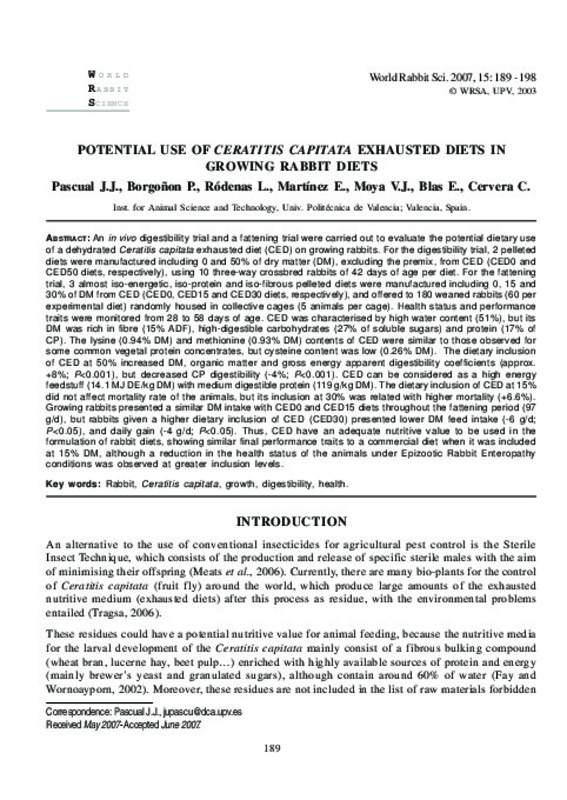JavaScript is disabled for your browser. Some features of this site may not work without it.
Buscar en RiuNet
Listar
Mi cuenta
Estadísticas
Ayuda RiuNet
Admin. UPV
Potential use of Ceratitis Capitata exhausted diets in growing rabbit diets
Mostrar el registro sencillo del ítem
Ficheros en el ítem
| dc.contributor.author | Pascual Amorós, Juan José
|
|
| dc.contributor.author | Borgoñón Gutiérrez, Pedro Pascual
|
|
| dc.contributor.author | Ródenas Martínez, Luis
|
|
| dc.contributor.author | Martínez Paredes, Eugenio Melchor
|
|
| dc.contributor.author | Moya Salvador, Vicente Javier
|
|
| dc.contributor.author | Blas Ferrer, Enrique
|
es_ES |
| dc.contributor.author | Cervera Fras, Mª Concepción
|
|
| dc.date.accessioned | 2009-05-11T10:56:02Z | |
| dc.date.available | 2009-05-11T10:56:02Z | |
| dc.date.issued | 2007 | |
| dc.identifier.issn | 1257-5011 | |
| dc.identifier.uri | http://hdl.handle.net/10251/4583 | |
| dc.description.abstract | [EN] An in vivo digestibility trial and a fattening trial were carried out to evaluate the potential dietary use of a dehydrated Ceratitis capitata exhausted diet (CED) on growing rabbits. For the digestibility trial, 2 pelleted diets were manufactured including 0 and 50% of dry matter (DM), excluding the premix, from CED (CED0 and CED50 diets, respectively), using 10 three-way crossbred rabbits of 42 days of age per diet. For the fattening trial, 3 almost iso-energetic, iso-protein and iso-fibrous pelleted diets were manufactured including 0, 15 and 30% of DM from CED (CED0, CED15 and CED30 diets, respectively), and offered to 180 weaned rabbits (60 per experimental diet) randomly housed in collective cages (5 animals per cage). Health status and performance traits were monitored from 28 to 58 days of age. CED was characterised by high water content (51%), but its DM was rich in fibre (15% ADF), high-digestible carbohydrates (27% of soluble sugars) and protein (17% of CP). The lysine (0.94% DM) and methionine (0.93% DM) contents of CED were similar to those observed for some common vegetal protein concentrates, but cysteine content was low (0.26% DM). The dietary inclusion of CED at 50% increased DM, organic matter and gross energy apparent digestibility coefficients (approx. +8%; P<0.001), but decreased CP digestibility (-4%; P<0.001). CED can be considered as a high energy feedstuff (14.1 MJ DE/kg DM) with medium digestible protein (119 g/kg DM). The dietary inclusion of CED at 15% did not affect mortality rate of the animals, but its inclusion at 30% was related with higher mortality (+6.6%). Growing rabbits presented a similar DM intake with CED0 and CED15 diets throughout the fattening period (97 g/d), but rabbits given a higher dietary inclusion of CED (CED30) presented lower DM feed intake (-6 g/d; P<0.05), and daily gain (-4 g/d; P<0.05). Thus, CED have an adequate nutritive value to be used in the formulation of rabbit diets, showing similar final performance traits to a commercial diet when it was included at 15% DM, although a reduction in the health status of the animals under Epizootic Rabbit Enteropathy conditions was observed at greater inclusion levels. | en_EN |
| dc.description.sponsorship | This research was financed by the company Tragsa S.A. We wish to express our gratitude to Mr. Jaime García de Oteyza and Mr. Rafael Argilés for their valuable collaboration throughout the experiment. English text version revised by Neil Macowan. | |
| dc.language | Inglés | en_EN |
| dc.publisher | World Rabbit Science. ICTA. UPV | |
| dc.relation.ispartof | World Rabbit Science | |
| dc.rights | Reserva de todos los derechos | es_ES |
| dc.subject | Digestibility | en_EN |
| dc.subject | Ceratitis Capitata | en_EN |
| dc.subject | Health | en_EN |
| dc.subject | Rabbit | en_EN |
| dc.subject | Growth | en_EN |
| dc.title | Potential use of Ceratitis Capitata exhausted diets in growing rabbit diets | en_EN |
| dc.type | Artículo | en_EN |
| dc.identifier.doi | 10.4995/wrs.2007.589 | es_ES |
| dc.rights.accessRights | Abierto | es_ES |
| dc.contributor.affiliation | Universitat Politècnica de València. Instituto de Ciencia y Tecnología Animal - Institut de Ciència i Tecnologia Animal | es_ES |
| dc.contributor.affiliation | Universitat Politècnica de València. Departamento de Ciencia Animal - Departament de Ciència Animal | es_ES |
| dc.contributor.affiliation | Universitat Politècnica de València. Escuela Técnica Superior de Ingeniería Agronómica y del Medio Natural - Escola Tècnica Superior d'Enginyeria Agronòmica i del Medi Natural | es_ES |
| dc.description.bibliographicCitation | Pascual Amorós, JJ.; Borgoñón Gutiérrez, PP.; Ródenas Martínez, L.; Martínez Paredes, EM.; Moya Salvador, VJ.; Blas Ferrer, E.; Cervera Fras, MC. (2007). Potential use of Ceratitis Capitata exhausted diets in growing rabbit diets. World Rabbit Science. 15(4). https://doi.org/10.4995/wrs.2007.589 | es_ES |
| dc.relation.publisherversion | https://doi.org/10.4995/wrs.2007.589 | |
| dc.description.volume | 15 | |
| dc.description.issue | 4 | |
| dc.identifier.eissn | 1989-8886 | es_ES |
| dc.contributor.funder | Empresa de Transformación Agraria, S.A. |








